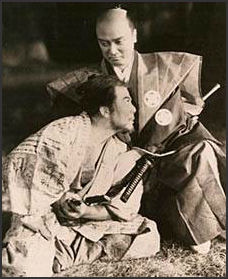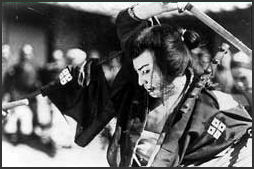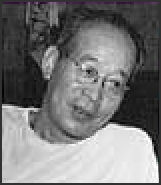CLASSIC JAPANESE FILMS AND FILMMAKERS

Mizoguchi's 47 Ronin Commenting on what makes Japanese film unique, Japanese film expert Donald Richie said, “While Western plot stresses occurrence, causality and responsibility, Japanese traditional narrative... emphasizes sequential flow, connection, association...The idea of narrative proceeding through harmony and similarity, not often encountered in Western cinema, is seen again and again in Japanese movies.”
Richie also observes that Japanese cinema is “singular in its closeness to popular literature” and identity is “more constructed than discovered.” Films often feature violent humor and violent sex. Richie has argued that violence is seen as “an aesthetic spectacle, the patterns of disorder are composed into compositions which filter the excitement and render beauty from chaos.”
Japanese film companies — especially big studios like Toho and Shochiku — have been loath to issue their classic films with English subtitles. It is not clear why. Some say it has to do with copyright concerns. Other have suggested by adding English it would somehow detract from the Japaneseness.
Websites and Resources
Good Websites and Sources: History o Early Japanese Film (1896-1912) cmn.hs.h.kyoto-u.ac.jp ; Essay on Benshi, Silent Film Narrators aboutjapan.japansociety.org ; Film Audiences in Postwar Japan cmn.hs.h.kyoto-u ; Japanese Cinema to 1960 greencine.com ; Yakuza Movies jingai.com/yakuza/movies ;
Famous Directors Google e-book: Yasujiro Ozu by Donald Richie /books.google.com/books ; Kenji Mizoguchi brightlightsfilm.com ;Nagisa Oshima Profile sensesofcinema.com ; Wikipedia article on Juzo Itami Wikipedia ; New York Times 2008 obituary on Kon Ichikawa nytimes.com ; Shohei Imamura Profile mastersofcinema.org
Links in this Website: JAPANESE FILM Factsanddetails.com/Japan ; CLASSIC JAPANESE FILMS AND FILMMAKERS Factsanddetails.com/Japan ; AKIRA KUROSAWA FILMS Factsanddetails.com/Japan ; GODZILLA Factsanddetails.com/Japan ; MODERN JAPANESE FILM INDUSTRY Factsanddetails.com/Japan ; MODERN JAPANESE FILMMAKERS AND FILMS Factsanddetails.com/Japan ; JAPANESE ACTORS AND HOLLYWOOD ACTORS IN JAPAN Factsanddetails.com/Japan ; HOLLYWOOD FILMS ABOUT JAPAN Factsanddetails.com/Japan
Books: “A Hundred Years of Japanese Film” by Donald Richie (Kodansha International, 2002); “Japanese Cinema — An Introduction” by Donald Richie (Oxford University, 1990). Good Websites and Sources on Japanese Film: Google e-book: A Hundred Years of Japanese Film by Donald Richie books.google.com/books ; Midnight Eye midnighteye.com ; Japanese Movie Listing lisashea.com/japan ;Kinema Club pears.lib.ohio-state.edu/Markus ; Japan Association for the International Promotion of the Moving Image unijapan.org/en ; Toei Uzumasa Movie Land is a theme park and movie studio were many samurai and historical drams have been shot. Website: Japan Guide japan-guide.com Asian Film Asia Society on Film asiasociety.org ; iFilm Connections — Asia and Pacific asianfilms.org ; Love Asia Film loveasianfilm.com ; Senses of Cinema sensesofcinema.com ; Illuminated Lantern on Asian Film illuminatedlantern.com
Databases, Directories, Links: Internet Movie Database /www.imdb.com ; Directory of Interent Sources newton.uor.edu ; Japanese Film Resources at the University of Iowa lib.uiowa.edu/eac/japan ; Tokyo International Film Festival tiff-jp.net ; DVDs Japanese, Chinese and Korean CDs and DVDs at Yes Asia yesasia.com ; Japanese, Chinese and Korean CDs and DVDs at Zoom Movie zoommovie.com ; CD Japan cdjapan.co.jp ;
Early History of Japanese Film

1925 film The first foreign motion pictures were shown in Japan in 1896. One of the Lumiere Brothers, the inventors of film, visited Osaka in 1897. By 1899, Japanese filmmakers were making their own films. During the silent era, for both foreign and domestic films, dialogues and explanations were provided by a narrator, called a “benshi”, whose duties were not all that different from a narrator in bunraku puppet drama.
Early Japanese films were mainly traditional theater captured on film. After the Tokyo earthquake in 1923, a number or historic films and films with modern themes were produced. Before World War II, the government became more involved in filmmaking and the result were a lot of propaganda pieces.
Teinosuke Kinugasa was a master Japanese silent film. He created “A Page of Madness” (1926), "a hallucinatory tale of an old man who works at an asylum in the hope of freeing his wife who is confined there. It has been said that his use of montage technique rivaled that of Eisenstein in “Battleship Potemkin”.

Ozu's Tokyo Story Early Japanese films dealt with traditional themes such as love versus duty, double suicides, family troubles and responsibility prevailing over emotion. Unfortunately 90 percent of Japanese films made before 1945 were destroyed, either by waves of firebombing in World War II or in the Great Tokyo Earthquake in 1923. Some were also destroyed as political propaganda by occupation forces after World War II.
Film has played an important role in Japan as a propaganda device, particularly for the military regime before and during World War II and then for the Americans after the war. The Manchurian Film Association produced a series of propaganda musicals and melodramas in the 1930s and 40s for Chinese audiences that invariably featured a romance between a beautiful Chinese woman and a handsome Japanese man. They were huge hits not only in China but other territories occupied by the Japanese.
Historians use old films to analyze the culture and get the pulse of nation at time when the films are made.
Golden Age of Japanese Film
After World War II, films with militaristic and nationalist themes were banned. In their place came comedies, monster films, animation and serious works. Among the serious works were Kajiro Yamamoto’s “Shin Baka Jidai” (“New Age of Fools.” 1947), shot at a bombed out set used by Kurosawa, and Kenji Mizoguchi’s “Yoru no Omnatachi” (“Women of the Night”). The Japanese were known for making first-rate, realistic-looking costume dramas the late 1940s.
The 1950s was the Golden Age of Japanese film. Acclaimed Japanese directors like Akira Kurosawa, Yaujiro Ozu and Kenji Mizoguschi did some of their best work. It was also a time when Japanese rushed to the theater to see the latest samurai dramas, yakuza action movies, comedies and song-and-dance movie. Over 1.1 billion people attended films at around 7,000 theaters in 1958.
Directors such as Oshima, Yoshishige Yoshida and Masahiro Shionada were leaders in the Japanese new wave in the 1960s. Some of the works leaned towards soft-core pornography. The movement helped inspire innovative independent film makers that came along later like Shohei Imamura, Jun Ichikawa and Juzo Itami.
“During the 1950s movies were the principal form of popular entertainment, but in the 1960s many people purchased their first television and stopped going to the movies, where attendance plummeted from the alltime high of 1.1 billion in 1958 to 246 million in 1970. Japanese films held a 70 percent share of the market through the 1950s, peaking at 78.3 percent in 1960. The Golden Age came to a close with the emergence of television as the main form of entertainment in the 1960s.
1954, the Gold Year of Japanese Film, and Keisuke Kinoshita
According to the Yomiuri Shimbun: “When talking about the golden age of Japanese movies, the year 1954 must not be excluded. The rich lineup of movies made that year is evident as you look at the annual top 10 movies published by the film magazine Kinema Junpo. "Chikamatsu Monogatari" by Kenji Mizoguchi (1898-1956) and "Shichinin no Samurai" (Seven Samurai) by Akira Kurosawa (1910-1998) settled for fifth and third places, respectively. The number one film, selected from among a variety of masterpieces and outstanding films, was "Nijyu-shi no Hitomi" (Twenty-four Eyes) by Keisuke Kinoshita (1912-1998), followed by "Onna no Sono" (Women's world) also directed by Kinoshita. [Source: Yomiuri Shimbun, October 4, 2012]
In addition to his movies "Carmen Kokyo ni Kaeru" (Carmen returns home) and "Ojosan Kampai" (Toast to madam), Kinoshita's TV series, including "Futari no Sekai" (A world of two) and "Oyaji Daiko" (Dad's drum), aired [from October 1964 to September 1974] on the "Kinoshita Keisuke Hour" will be shown. Visitors will be able to experience the charm of Kinoshita, who could be described as a "poet of visual images.” Ten years ago an admission ticket to the Memorial Museum in Hamamatsu had a piece of colored paper photocopied on its surface. Autographed by Kinoshita, the paper contained his message: "I hope you'll become people who can sympathize with both the joys and sorrows of human lives--Keisuke.”
Classic Japanese Directors
The three most famous classic Japanese directors are Akira Kurosawa, Kenji Mizoguchi and Yasujiro Ozu. Kurosawa Akira greatly spurred international interest in Japanese films when his production “Rashomon” (1950) won the Golden Lion Award at the Venice Film Festival in 1951. His other works include “Ikiru” (1952, To Live”), “Shichinin no samurai” (1954, “Seven Samurai”), Kagemusha” (1980, “The Shadow Warrior”), and Ran” (1985). Kurosawa won the Best Foreign-Language Film Academy Award for “Dersu Uzala” in 1975, and at the Academy Awards ceremony held in 1990 he received a special honorary Oscar for his lifetime achievements as a cinematic artist. [Source: Web-Japan, Ministry of Foreign Affairs, Japan]
See Separate Article on Kurosawa
Ozu Yasujiro directed such films as “ Banshun” (1949, “Late Spring”) and “Tokyo monogatari” (1953, “Tokyo Story”). In these films he depicts in poetic terms the sensibilities of the life of Japan’s ordinary people. His scene-joining techniques (using neither fade-ins nor fade-outs) have had a great influence on European film makers.
Other acclaimed directors from Japan’s Golden Age of Film include Shiro Toyoda, director of “The Mistress” (1953), “A Cat, Two Women and One Man” (1956); Masaki Kobayashi, who made “The Human Condition” trilogy (1959-1961) and “Hari-kiri” (1962); and Hirsohi Teshigahara “Women of the Dunes” (1964).
“Miyamoto Musashi” by Hiroshi Inagaki won the Academy Award in 1955. It is about Miyamoto Musashi, a legendary early Edo-period swordsman who reportedly killed 60 men before his 30th birthday and was also a painting master. Inagaki’s “Muhomatsu ni Issoh” (“Matsu the Untamed”) won the top ward at the Venice Film Festival.
Some classic Japanese directors such as Masahiro Shinoda and Seijun Suzuki are still active. Kinji Fukasaku made “Black Lizard” in the 1960s and “Battle Royale” in 2001. Film director Yoshimitsu Morita died of acute liver failure in December 2011 at the age of 61. After making his directorial debut in 1981 with No Yona Mono (Something Like It), Morita became best known for Kazoku Game (The Family Game) in 1983. Another standout film was Shitsurakuen, which later became a slang word for having an affair.
“The dominant director of the 1970s was Yamada Yoji, whose overwhelmingly popular success was the “Torasan” series. These films fused two bedrock motifs of Japanese film: the everyday collective life of a family and the adventures of a lonely wanderer.
Yasujiro Ozu

Yasujiro Ozu (1903-1963) is one of Japan’s great film makers. Regarded as one of the most Japanese of all directors, he made melodramatic films about Japanese families dealing with modernization and is known for blending modern and traditional techniques and using single-frame, low-positioned “tatami” camera shots to great effect. Ozu was a heavy drinker and he once said that plot bores him. He was famous for doing 10 to 20 takes for the simplest actions.
Richard Brody wrote in The New Yorker website: “Ozu’s compositions are impulsive and energetic, matching the surprising vigor of the free-spirited, audacious, [Source: Richard Brody, The New Yorker website, July 23, 2010]
Ozu’s films include “I Was Born” (1932), “Early Summer” (1951), “Early Spring” (1956), “Good Morning” (1959), and “An Autumn Afternoon” (1962). “Floating Weeds” (1959), a remake of his silent classic, is about a theatrical troupe and its experience in a small town where the leader of the troupe fathered an illegitimate child. It has been described as “immaculately serene, quietly poignant.” “Early Summer” features the great Setsuko Hara, playing a daughter whose family gathers to select a husband for her. Most of his works are available on DVD. His last film was “An Autumn Afternoon” .

Tokyo Story “Tokyo Story” (1957) is considered a masterpiece and was selected by Time magazine as one of the “All-Time 100 Movies.” It is about parents who are disillusioned with their self-centered, grown up children. One critic wrote it “breaks our hearts with all all the things it “isn’t” showing us. Everything is nuanced, delicate; the way a man sips his sake says as much about his soul as a soliloquy.”
Richard Brody wrote in The New Yorker website: “Ozu’s second sound film, “What Did the Lady Forget?” (1937) opens with a shot that is both graphically alluring and socially declamatory — a closeup of a glossy fender and tail-light of an imposing, American-style car in motion. The shot sets up the film’s first dramatic contrast — that of its passenger, a stylish young woman, Setsuko, and her Euro-American clothing, with her aunt and her traditional Japanese garb — and since her uncle, a doctor and med-school professor, is soon shown to wear Western-style suits, the plot’s lines of conflict are established from the start.
“Even brazen young woman who defies the codes of proper behavior and (spoiler alerts for what follows) gives hardly a hoot for whose name she tarnishes along the way. Her aunt, by contrast, a domestic tyrant, dominates her easygoing (yet deceptive) husband with her imperious propriety. Yet, for all the trouble that ensues, Setsuko turns out to be a sort of welcome spice in the household, and the film’s dénoument — in which husband slaps wife — comes off as the sort of offhanded cruelty that Ozu so often depicted as standard practice in Japan yet which, here, he presents as a sign of manhood, one which his wife even boasts about to her friends! And which they envy her for! The concluding scene of tender conjugal eroticism leaves no doubt as to what Ozu thought women want; yet I wonder whether the story doesn’t have significant documentary value, for what it suggests of Japanese mores of the time. I wish I knew how the movie was received there then.”
Kenji Mizoguchi

Kenji Mizoguchi (1898-1956) is also regarded as one of the great Japanese directors. He explored the role individualism in traditional Japan, was partial to protracted shots, routinely fired assistants, required sets to be built with extraordinary detail and was so demanding he once complained to a writer that his script “failed to portray people so real that the audience could smell their body odor.”
Mizoguschi was greatly admired by French New Wave directors for his skill at blending realism with aesthetics. Among his films are “Resurrection of Love” (1922), “The Sister of Gion” (1936), “Osaka Elegy” (1936), “Genroku Chushinguraa” (“The Loyal 47 Ronin,” 1941-42), “Saikaku Ichidai Onna” (“The Life of Oharu,” 1952), “Ugetsu” and “Sansho the Bailiff” (1954) won awards in consecutive Venice Film Festivals, giving him international recognition in the years before his death. “Sansho the Bailiff” is named after the film’s villain. Only a few of his works are available on DVD.

Ugetsu Mizoguchi’s masterpiece, “Ugetsu” (1953), is a haunting, horrifying film about two couples who endure "every degradation of war, beyond pain, beyond death” and deals with a porous boundaries between the real world and the spiritual world. Highly critical of Japan's role in World War II, it was voted the forth best movie ever made in a 1962 Sight and Sound poll and 10th in a 1972 poll by the same magazine.
The New Yorker film critic Pauline Kael described “Ugetsu” as “a subtle, violent yet magical film” that “is unsettling and unspeakably cruel at times; and then is so suggestive and haunting that it’s confounding...Mizoguchi gives the narrative in two styles: barbaric sequences dealing with greed and civil war...and romantic moods of life.”
“Saikaku Ichidai Onna” is set in the 1700s. It is about Oharu, the beautiful daughter of a samurai serving at the Imperial palace who falls in love with a page who is beheaded for breaking the social code and is sent with her family to the country, where she is recruited by a warlord to bear him a son and is then is dismissed and forced to work as a prostitute.
Image Sources: YouTube, Bright Lights, Japan Zone, Realms of Cinema, Amazon
Text Sources: New York Times, Washington Post, Los Angeles Times, Daily Yomiuri, Times of London, Japan National Tourist Organization (JNTO), National Geographic, The New Yorker, Time, Newsweek, Reuters, AP, Lonely Planet Guides, Compton’s Encyclopedia and various books and other publications.
Last updated July 2011
